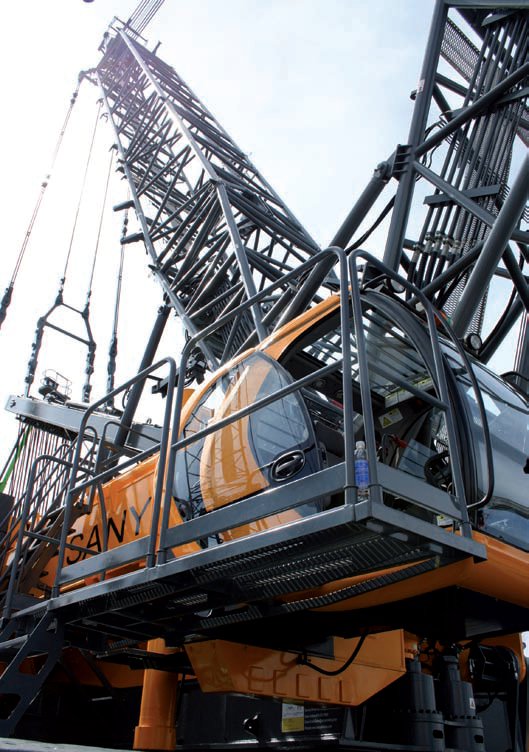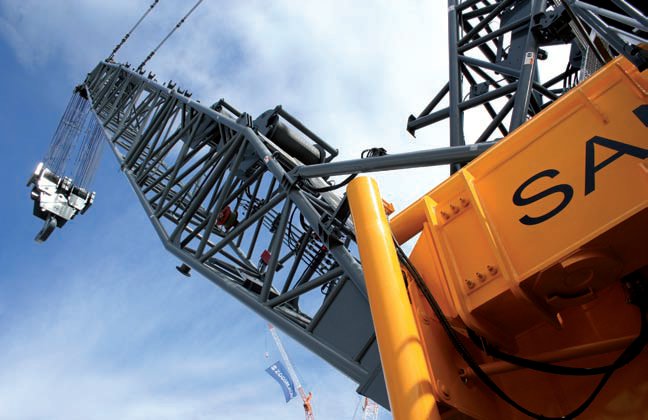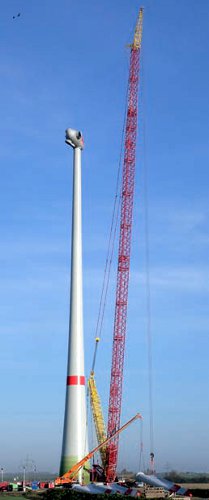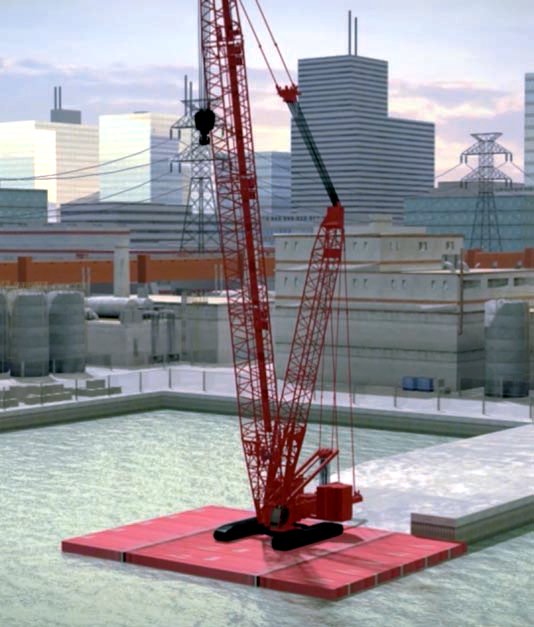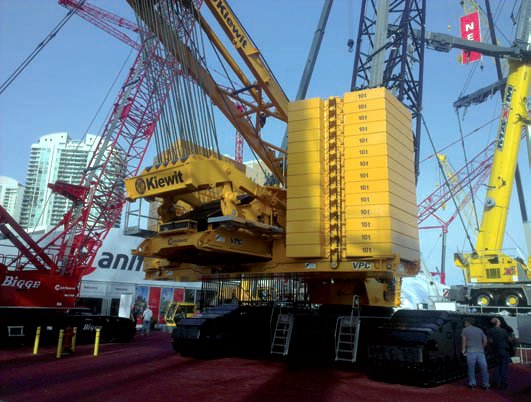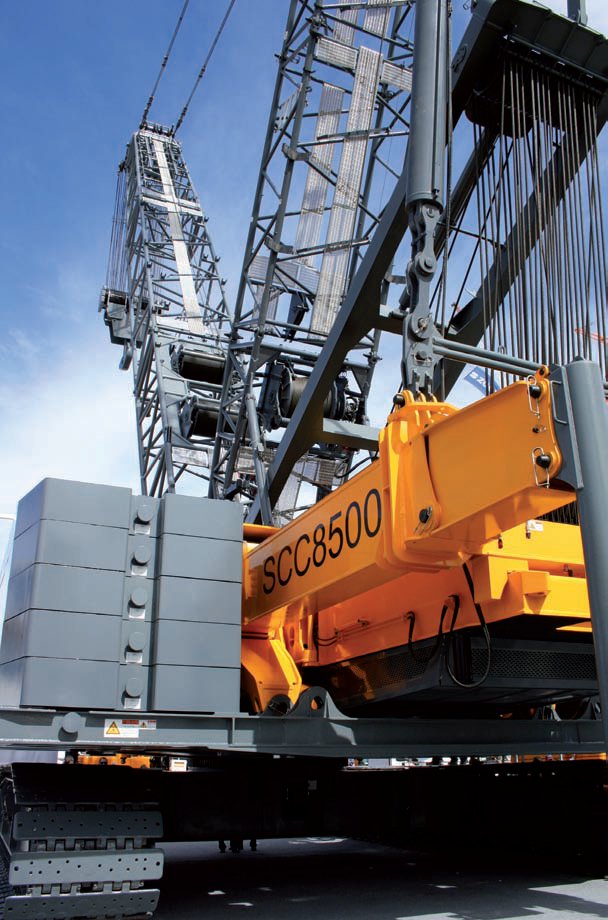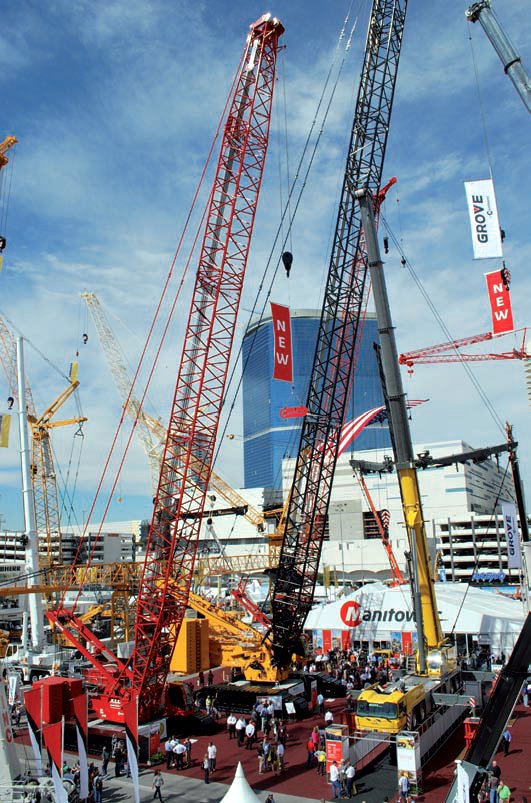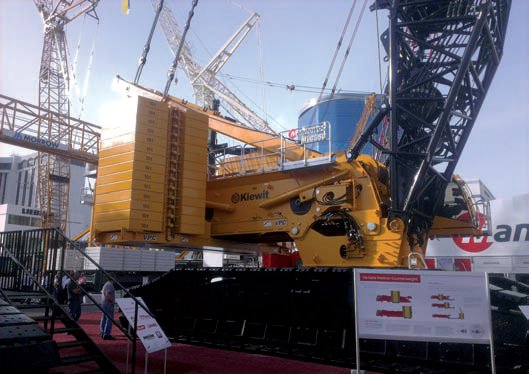A heavyweight bout in Vegas
17 April 2014At this year’s ConExpo, Sany and Manitowoc, on one hand, and Terex, on the other, presented starkly different visions of how to handle lifts in the 500–650t capacity class. Liebherr, recently, has presented its own take on some jobs in this range, launching a new boom system for its own 600-tonner. Will North reports.
Looking around the outside exhibition areas at this year's ConExpo, it would be hard to miss the heated competition in the 500-650t crawler crane capacity class.
Towering over the Gold Lot with an 84m main boom and 60m luffing jib was Terex's successor to the popular CC 2800, the Superlift 3800. With its counterweight mounted on a moving trailer at the rear, the Terex offers an up-to-date take on how to achieve the flexibility needed by cranes in this class.
Manitowoc and Sany, facing off against each other at a distance in the Gold and Silver lots (as well as at the USITC, where Manitowoc is accusing its Chinese rival of infringing patents), presented an alternative vision, using floating counterweight systems to offer similar flexibility, with less requirement for ground preparation.
Liebherr, who launched their LR 1600/2 two ConExpos ago in 2008, didn't have a crawler crane in this class at the show. They have, however, recently launched a new boom system, the SL10, that extends the crane's lifting height, making it more suitable for modern wind turbine jobs.
Not just features
Terex launched the Superlift 3800 in late October 2012, with the first machine becoming available at the end of that year.
Francois Truffier, Terex Cranes group vice president, global marketing, product and commercial strategy, says, "Sales have gone very well. This machine has been built with the customer in mind.
When we started marketing the machine, everyone was amazed by its performance levels, which, in some configurations compare to 750t machines from competitors."
The crane demonstrates, Truffier says, Terex's focus on customer return on investment. He says, "We wanted to show value, not just boom or load. This crane takes much less counterweight than other machines in this class, which translates into a certain number of trucks that aren't needed. That's particularly important on job sites like wind farms.
"We're building our message on the package, not just on features. It took time to sell to customers. Initially, they said, it's an expensive machine. But then, we said, look at the operational costs over the lifetime of the machine.
"We're now seeing a lot of sales. A lot of our customers for this type of crane are now buying multiple units of this machine. At a very loose guess, we've now sold more than 20 units so far. On crawler cranes over 300t, we're very happy with our market share."
The crane demonstrates Terex's approach to working with customers. Tim Ford, president of Terex Cranes, says, "This is a very important crane for Terex. Improving on an already great crane, we created a completely new one by leveraging our customer driven innovation process which combines our experience with a focus on solving the needs of the customer. And this illustrates perfectly what Terex Cranes is about."
"When we started this project, we set ambitious goals," says Hans- Peter Franzen, project director. "And I am proud to say that we exceeded them." System rigidity has been improved: for example the light extension LF can now lift loads up to 178t. The Superlift 3800 can be delivered with an integrated wind kit in a universal main boom system: the crane is capable to erect wind turbines of 117m without using the the available superlift boom configuration. An assist crane is not required to help erect the main boom.
At ConExpo, the crane was displayed in SWSL configuration, with 84m of main boom and a 60m luffing jib. The crane carried 165t of superstructure and 50t of central ballast, as well as 205t of counterweight on the telescoping wagon.
The crane on show in Las Vagas was sold to AmQuip. Al Bove, COO, AmQuip says: "We organized our team of crawler experts, fleet managers, and project principles to review all of the cranes available in this class. After a lengthy and well thought through process our team unanimously decided that the 3800 was overall the "Best Crane Offered In This Class". AmQuip purchased the crane with all available options, including luffing jib and mobile counterweight wagon."
This investment is part of AmQuip's strategy to invest in high quality equipment to deliver effective and efficient solutions to their customers, Jon Capuzzi, Chief Product Officer, says, "With project work increasing, AmQuip wanted to set itself apart from the competition. Knowing Terex's product is proven, AmQuip's team decided that purchasing the SL3800 will be a solution for AmQuip customer's lifting requirements.
Float like a butterfly
While Terex's counterweight is mounted, via a telescoping connector, to a truck, machines from Sany and Manitowoc both adopt new floating counterweight systems, reducing the cranes' footprint.
Across the Gold Lot from Terex, Manitowoc was launching two new crawlers, the 300t MLC300 and 650t MLC650. In the Silver Lot, Sany showed its new 500t crawler, the SCC8500.
Both cranes use a hydraulically powered and computer controlled tray to move the counterweight back and forth as the crane works. The advantage claimed for these systems is that, as the counterweight never touches the ground, the crane's footprint is much smaller than on a stinger-style system like Terex's, reducing the need for ground preparation on sites like wind farms.
Sany was first to announce a crane with floatable, movable, counterweight, revealing the SCC8500 in the spring of 2012. At ConExpo 2014, it showed the crane publicly for the first ever time.
Jeff Dreger, director, product and customer support, Sany America, says, "This is the the first one of these machines in the States, and its first time at a show. It's not even for sale, we still have some refinements and testing to do. When it's finished at the show, it will be dismantled and taken down to [Sany America's facility in] Peachtree City, Georgia, to do some final testing.
"It has a movable counterweight system, that is dependent on boom angle. There are two versions. The standard ACE package is the automatic counterweight equalisation system. That uses one of the cylinders and moves a single counterweight tray back and forth on the box beam.
"Then there's the Ultralift package, which adds another cylinder on the box beam, and then the box itself telescopes back 13m. With that package, you also get the back mast."
The crane looks, to a non-engineer, a little more complicated than a standard crawler. However, Dreger says, that innovation pays off.
"Assembly time is really good. We put it up here at the show in two days. None of the [assembly] loads are over 100,000lb.
"It's got a lot of the other standard features that our products have, such as cameras, free-fall on the main drum.
"It's a 550USt machine, built mainly for power plant applications, construction, and for wind turbine lifts. One of the features when we were designing this machine, was to be able to lift 100t at 100m high. We achieved that with this machine."
The crane features two very promonent outriggers on the back of the counterweight tray, floating a foot or two from the ground. Dreger says, "These are only there for safety. There are instances, say if you had to drop the load, or set the load down quickly, that the machine couldn't counteract, so you would set down on them at that point."
While the SCC8500 and its ACE system may have been made public before the two Manitowoc cranes, the order in which they were developed has become controversial, with Manitowoc taking Sany to the US International Trade Commission, complaining of patent infringements.
It was as a result of those proceedings that Cranes Today was able to predict Manitowoc's plans for the two new VPC machines, back in June of 2013.
At ConExpo, the US manufacturer confirmed our prediction, with two new machines, the MLC300 and MLC650. Both cranes feature the company's VPC variable position counterweight system, originally developed for the giant Model 31000. In the Model 31000 version, the counterweight is suspended from an articulated arm; in the version on the two new MLC cranes, this is not needed, and the counterweight tray is moved using hydraulic rams.
As with the Sany system, the Manitowoc cranes have both a standard and Super lift option. In the standard VPC, the counterweight is moved using a rack and pinion. For the Superlift version, that rack and pinion system is moved further back and forth hydraulically, while still being able to operate fully.
It's a system Manitowoc is very excited about. Larry Weyers, global executive vice president, responsible for engineering, sales and marketing, says "We looked at 100m wind tower work. With this load moment and VPC, you're able to raise 350ft of boom, without outriggers, and lift 130t of weight. With the load up and counterweight pulled in, you can crawl across wind turbine job sites. That was one of the key markets, to be able to raise that load. The MLC650 is ready for 3mW turbines."
One of the key selling points Manitowoc used at the show was the footprint required for the crane. The company made explicit comparison with other manufacturer's machines.
Weyers says, "On the MLC 650, with Superlift, you only need 1,140sq ft, of space, compared to 11,000sq ft for [rival manufacturers cranes with a similar capacity]. That makes it much more maneuverable on cramped sites. When lifting, the VPC beam comes out and pushes the counterweight right back. There are no tailswing issues.
"Its capacity matches cranes from competitors, but with much less counterweight, and fewer truck loads. There is ten times less surface to prepare."
It wasn't just the crane's potential on wind farms that had got Manitowoc and its customers excited. One of the selling tools for the crane has been a video presentation demonstrating it's potential for use on the water, with the crane only needing a barge big enough to support the crawlers, and the VPC moving the counterweight out over the back of the vessel when lifting.
Despite the secrecy surrounding the launch, Manitowoc has been reaching out to customers and taking orders for the new crawler cranes.
Weyers says, "We've had great input from customers. We've already sold more than 50 machines between the two.
"When we talk to customers, they use words like game changing. Once called it "the internet of cranes". You always have those incremental improvements, but then you have those that really change value for customer."
As well as the giant EPC Kiewit, in whose colours the MLC650 at ConExpo was painted, Manitowoc also announced a major sale of ten cranes to All Erection, including the MLC300 on display in Las Vegas.
Making it better
While Terex, Manitowoc and Sany all launched new cranes in this category, Liebherr has been selling its 600t contender since 2008's event. But, as the market for these cranes, and particularly the wind turbine sector, asks for more capacity at height, it has kept up with a new main boom system, the SL10.
The SL10, combined with a fixed jib increases load capacity by up to 20%. It increases the crane's hoist height by 15m to over 160m. And the LR 1600/2 still has a load capacity of 71t at this height. A comparison with the standard system shows an increase in load capacity from 77t to 92t at a hoist height of 147m. This means that the new SL10 system can erect the latest generation of wind turbines with tower heights of up to 150m.
